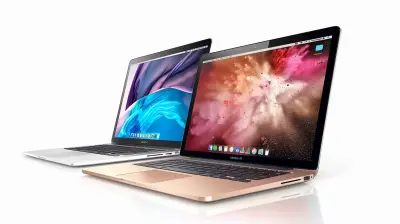The Future of eSIMs: Simplifying Connectivity Everywhere
26 July 2025
Imagine a world where switching mobile networks is as easy as changing your Spotify playlist. No more fiddling with tiny SIM cards, no more searching for paper clips to pop open that fiddly SIM tray. Welcome to the future of connectivity — where eSIMs are revolutionizing how we stay connected to the world around us.
As we march deeper into the digital age, eSIMs are slowly but surely kicking traditional SIM cards to the curb. They offer a more flexible, secure, and hassle-free way to manage mobile connectivity — and that’s just the tip of the iceberg. So grab your favorite drink, kick back, and let’s dive into the exciting world of eSIMs and how they’re simplifying connectivity all around the globe.
What is an eSIM, Anyway?
First things first — what the heck is an eSIM?Well, the "e" in eSIM stands for "embedded." That’s right — instead of being a tiny plastic card you need to insert into your phone manually, an eSIM is soldered right into your device’s motherboard. No physical swapping, no fiddling around.
It’s basically a small chip that works just like a traditional SIM, but it’s built into your phone, tablet, smartwatch, laptop — or even your car! And yes, it still identifies your device to a mobile network and stores all the same info. But here’s the kicker: you can program it with different network profiles, activate it remotely, and switch carriers in a flash. Pretty cool, right?
How We Got Here: A Quick SIM Card History Lesson
Before we go full nerd mode, let’s take a quick stroll down memory lane.Remember those OG full-sized SIM cards? Yeah, they were basically the size of a credit card. Over the years, we’ve seen them shrink from Mini SIMs to Micro SIMs to Nano SIMs. But no matter how small they got, they were still physical cards.
Then came the game-changer: eSIM. Introduced around 2016 and first used in smartwatches, it’s now making its way into flagship phones, laptops, and even smart cars. And why not? It’s lighter, smarter, and much more versatile.
Why eSIMs Are Big Time Game-Changers
Alright, let’s get into the juicy stuff. Why is everyone buzzing about eSIM?1. 💡 Instant Network Switching
Ever traveled abroad and had to go through the whole drama of finding a local SIM provider, buying a SIM, FINALLY getting it to fit, and then praying it works? With eSIM, you can just download a profile for a local carrier, and boom — you’re connected.It’s like having a digital passport for your device.
2. 📲 Dual SIM Action Without The Bulk
Want two numbers on one phone? No problemo! eSIM lets you have multiple network profiles. So, you can rock your personal and work numbers on the same device. This is especially handy for digital nomads, business travelers, or just us multitaskers who want to keep things tidy without juggling two phones.3. 🔐 Better Security
Here’s a fun fact most people don’t know: eSIMs are actually safer than physical SIMs. Why? Because there’s nothing to steal or clone. You can't just pop an eSIM out of a phone and use it elsewhere. They're protected by built-in encryption, and losing your phone doesn't mean someone else can suddenly hijack your number.4. 🌱 Eco-Friendliness FTW
No plastic, no packaging, no shipping. An eSIM is delivered via the magic of the internet. That’s one less piece of plastic headed for the landfill, and if you multiply that by the millions of SIM cards used globally... well, Mother Earth is definitely grateful.
Where Are eSIMs Being Used Today?
You might be thinking, "All this sounds amazing, but is anyone actually using eSIMs right now?"Oh yes, and in more places than you'd guess!
Smartphones
Most modern flagship smartphones now support eSIM. Apple embraced it big time, especially with the iPhone 14 lineup, which ditched the SIM tray altogether in the U.S. Other brands like Samsung, Google, and Motorola are hot on their heels.Smartwatches & Wearables
Wear your connection on your wrist? Heck yeah! Devices like the Apple Watch and Samsung Galaxy Watch use eSIM to let you take calls, send texts, and stream music — without needing your phone nearby.Laptops & Tablets
Devices like the Microsoft Surface Pro and certain iPad models include eSIM so you can stay online wherever you roam. Whether you’re sipping a latte at your local café or answering emails from a beach chair in Bali, eSIM keeps you productive.Automobiles
Yup, even your car can rock an eSIM. Ever heard of connected cars? Think GPS, live traffic updates, emergency calls, remote diagnostics — all powered by a tiny chip that doesn’t need a traditional SIM card.The Travel Game Just Got an Upgrade
Let’s say you’re flying from New York to Tokyo. Before eSIM, you’d either have to stick with your home carrier’s pricey roaming plan or figure out how to get a Japanese SIM card.But now? You whip open your phone, pick a local eSIM plan before you even leave the airport, and you’re connected faster than you can say arigatou. Some apps even let you scan a QR code, and voilà — you're online.
For frequent fliers and remote workers hopping through time zones like it’s no big deal, eSIM is a total game-changer.
Roadblocks on the Path to eSIM Domination
Now, before we all throw a party for eSIM, let’s keep it real — it’s not all sunshine and rainbows just yet.Not All Carriers Are On Board (Yet)
Even though the tech is out there, not every carrier supports eSIM. Some are dragging their feet, especially in markets where eSIM adoption hasn’t hit critical mass. But the tide is turning, and fast.Device Compatibility Issues
Not every device supports eSIM — at least not right now. Budget and older models often don’t have the built-in chip, which means this cool tech is still somewhat exclusive club territory. For now.Learning Curve
Let’s be honest — for some folks, setting up an eSIM sounds like hacking into the Matrix. But just like we once learned how to send emails, swipe right, and use TikTok filters, we’ll adjust. The process is actually pretty easy once you’ve done it once or twice.What’s Next for eSIM Technology?
So what’s on the horizon? Buckle up.eSIM-Only Devices Will Become the Norm
Apple’s already there in the U.S., and other manufacturers are circling the waters. The day’s coming when SIM trays are as outdated as headphone jacks — and that’s not a bad thing. Removing physical ports and slots makes devices sleeker, more waterproof, and easier to design.More Global Carrier Support
As demand grows, more carriers around the globe will jump on the eSIM bandwagon. With international players and startups offering low-cost eSIM data plans, the old guard will have to keep up or get left behind.IoT Will Explode with eSIM
The Internet of Things (IoT) is exploding — think smart home devices, security systems, even your fridge. These gadgets need simple, scalable connectivity, and eSIM delivers just that. With remote provisioning, manufacturers can ship devices fully connected right out of the box.Better Management Tools
Expect slicker mobile apps and user interfaces that make it super simple to manage your eSIM profiles. Switching between work and travel plans, updating your data allotments, or adding emergency backup profiles will be as easy as ordering pizza on your phone.Should You Make the Switch?
If your device supports eSIM and your carrier offers it — go for it! There’s no reason not to ride the wave of the future. You’ll reduce clutter, gain flexibility, and have more control over your mobile connections.Sure, there are still some hiccups, but the benefits far outweigh the hassles. Whether you’re a digital nomad, a globe-trotting manager, or just someone who hates tiny SIM trays (honestly, who doesn’t?), eSIM is your new best friend.
Final Thoughts: The eSIM Era is Here
The future of eSIMs is looking brighter than a brand-new OLED screen. It’s a leap forward, not just in tech, but in how we interact with the digital world. Everything’s becoming smarter — so why should our connectivity stay stuck in the 2000s?As more devices, carriers, and users wake up to the magic of eSIM, we’re headed toward a world that’s always-on, always-connected, and startlingly seamless. And the best part? You don’t need a toolbox to get connected anymore — just a few taps on your screen.
So go ahead — ditch the plastic, embrace the chip, and simplify your digital life one download at a time.
all images in this post were generated using AI tools
Category:
Tech TrendsAuthor:

Gabriel Sullivan
Discussion
rate this article
1 comments
Seraphis Hodge
Absolutely thrilled to see the exciting possibilities of eSIM technology! 🌟 It’s a game-changer for connectivity, making our lives easier and more connected no matter where we go. Can’t wait to experience seamless global communication without the hassle of physical SIMs! Keep innovating! 📱✨
August 6, 2025 at 11:28 AM

Gabriel Sullivan
Thank you for your enthusiasm! We're excited about the potential of eSIM technology to enhance connectivity and simplify communication globally. Stay tuned for more innovations! 📱✨

